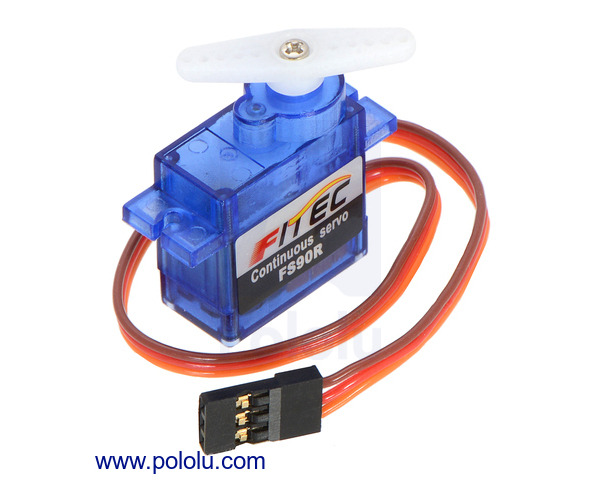

This is a merged information page for Item #2820.
View normal product page.
Pololu item #:
2820
Brand:
FEETECH

The FS90R is a micro servo that has been built by FEETECH specifically for continuous rotation, offering an inexpensive and easy way to get your small turret spinning or miniature robot moving, especially when paired with our 60×8mm wheels designed specifically for this servo. This servo can work with both 5 V and 3.3 V servo signals.
Key specs at 6 V: 130 RPM (no-load), 21 oz-in (1.5 kg-cm), 9 g, CCW rotation for pulse widths above the rest point.
 Compare all products in Continuous Rotation Servos or
Compare all products in Continuous Rotation Servos or  FEETECH Servos.
FEETECH Servos.
 |
FEETECH FS90R micro continuous rotation servo. |
|---|
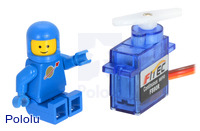 |
FEETECH FS90R micro continuous rotation servo with a LEGO Minifigure as a size reference. |
|---|
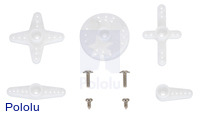 |
An example of hardware included with the FEETECH FS90 and FS90R micro servos. Actual hardware might vary. |
|---|
 |
60 mm and 40 mm Pololu Wheels for Micro Servo Splines on FEETECH’s FT90R and FS90R micro continuous rotation servos. |
|---|
 |
Bottom view of FEETECH FS90R micro continuous rotation servo (V2.0) showing middle-point adjustment potentiometer. |
|---|
 |
FEETECH FS90R micro continuous rotation servo V2.0 compared to the original V1.0. |
|---|
 |
FEETECH FT90R Digital Micro Continuous Rotation Servo and FS90R (analog) Micro Continuous Rotation Servo. |
|---|
 |
Continuous rotation servo size comparison. From left to right: SpringRC SM-S4303R, Power HD AR-3606HB, FEETECH FS5106R, Parallax Feedback 360°, Parallax (Futaba S148), and FEETECH FS90R. |
|---|
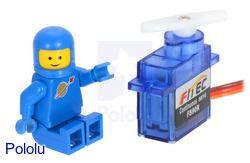 |
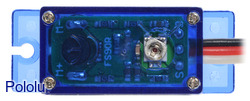 |
Bottom view of FEETECH FS90R micro continuous rotation servo (V2.0) showing middle-point adjustment potentiometer. |
|---|
The FS90R is a micro-sized servo that has been built by FEETECH (formerly known as Fitec) specifically for continuous rotation. At 6 V, it has a maximum rotation speed of around 130 RPM (no-load) and can produce up to 21 oz-in (1.5 kg-cm) of torque. The servo can be controlled using a direct connection to a single microcontroller I/O line without any additional electronics, which makes it a great miniature actuator for beginner robotics projects; just throw on a pair of wheels and your robot is ready to roll!
The FS90R continuous rotation servo converts standard RC servo position pulses into continuous rotation speed. The default rest point is 1.5 ms, but this can be adjusted by using a small screwdriver to turn the middle-point adjustment potentiometer. Pulse widths above the rest point result in counterclockwise rotation, with speed increasing as the pulse width increases; pulse widths below the rest point result in clockwise rotation, with speed increasing as the pulse width decreases.
The servo has a 10″ (250 mm) lead that is terminated with a JR-style connector and includes additional servo horns and mounting hardware. The following picture shows an example of the hardware that might be included (actual hardware could vary):
 |
This robotics servo, which is a continuous rotation version of the FEETECH FS90, is compatible with our servo controllers. If you are looking for a similar servo that is capable of limited-range position control as opposed to continuous rotation speed control, consider the FS90, which has identical dimensions and uses the same motor, or the Power HD micro servo HD-1900A, which has almost the same weight, speed, and torque as the FS90.
Note that, as with most hobby servos, stalling or back-driving this servo can damage it.
If you want to use this servo as an actuator for your miniature robot, you will need a wheel to go with it. Fortunately, we carry compatible servo wheels for micro servos (21T, 4.8 mm spline):
 |
60 mm and 40 mm Pololu Wheels for Micro Servo Splines on FEETECH’s FT90R and FS90R micro continuous rotation servos. |
|---|
The 60×8mm wheel allows for a top speed of around 42 cm/s (1.3 ft/s) at 6 V.
 |
Continuous rotation servo size comparison. From left to right: SpringRC SM-S4303R, Power HD AR-3606HB, FEETECH FS5106R, Parallax Feedback 360°, Parallax (Futaba S148), and FEETECH FS90R. |
|---|
| 6 V | 4.8 V | Weight (g) | Size (mm) | Direction vs pulse (1ms → 2ms) |
Digital? | Feedback? | Price | |||
|---|---|---|---|---|---|---|---|---|---|---|
| Max speed (RPM) |
Stall torque (oz·in) |
Max speed (RPM) |
Stall torque (oz·in) |
|||||||
| SpringRC SM-S4303R | 54 | 71 | 43 | 46 | 41 | 41.3 × 20.7 × 40.2 | CW→CCW | $21.39 | ||
| SURPLUS SpringRC SM-S4303R 2-Pack | 54 | 71 | 43 | 46 | 41 | 41.3 × 20.7 × 40.2 | CCW→CW | $24.74 for a pair of servos | ||
| FEETECH FS5106R | 95 | 83 | 75 | 67 | 43 | 40.8 × 20.1 × 38.0 | CW→CCW | $24.35 | ||
| Parallax Feedback 360° | 140 | 35 | – | – | 41 | 40.0 × 20.0 × 37.2 | CW→CCW |  |
 |
$29.95 |
| FEETECH FT90R | 135 | 21 | 108 | 18 | 9 | 22.9 × 12.1 × 26.5 | CW→CCW |  |
$12.63 | |
| FEETECH FS90R | 130 | 21 | 100 | 18 | 9 | 22.5 × 12.1 × 23.4 | CW→CCW | $9.82 | ||
| Size: | 22.5 × 12.1 × 23.4 mm |
|---|---|
| Weight: | 9 g |
| Digital?: | N |
|---|---|
| No-load current @ 6V: | 130 mA |
| Stall current @ 6V: | 800 mA1 |
| Speed @ 6V: | 130 rpm |
| Stall torque @ 6V: | 21 oz·in1 |
| Speed @ 4.8V: | 100 rpm |
| Stall torque @ 4.8V: | 18 oz·in1 |
| Hardware included?: | Y |
| Lead length: | 10 in |
Note: the free-run speed specifications appear to be incorrect in this datasheet. In our tests, the maximum no-load speeds were 130 RPM at 6 V and 80 RPM at 4.8 V, and these are the numbers we have published on our product page.
 |
Most standard radio control (RC) servos have three wires, each a different color. Usually, they are either black, red, and white, or they are brown, red, and orange/yellow:
Please check the specs for your servo to determine the proper power supply voltage, and please take care to plug the servo into your device in the proper orientation (plugging it in backwards could break the servo or your device).
Note: Some of the servos we carry also have an optional fourth green wire that is separate from the three standard ones. This wire provides access to the feedback potentiometer, allowing you to directly measure the position of the output. The servos with this extra wire have "with Position Feedback" at the ends of their product names. The picture below is an example of such a servo.
 |
FEETECH Sub-Micro Servo FS0403-FB with Position Feedback. |
|---|
We are thrilled to announce the release of our wheels for micro and standard sized servos. These wheels are similar to our wheels for 3mm D shafts...
We are now carrying the FEETECH FS90 micro servo. At a weight of only 9 g and less than inch long, this servo is great for actuating tiny...
Continuous rotation servos like FEETECH’s FS90R are popular actuators for beginner robots because of their low cost and ease of use—since the motor...
Continuing with our recent theme of tiny new actuators, we are now carrying FS90R micro continuous rotation servos from FEETECH. Continuous...